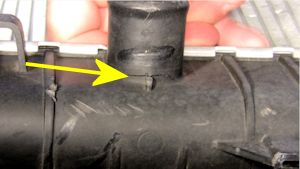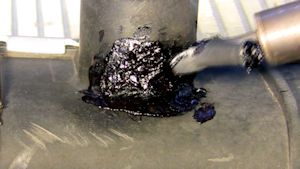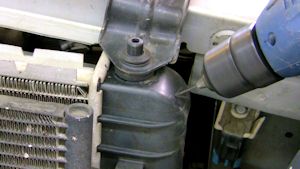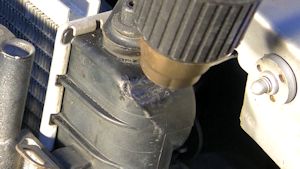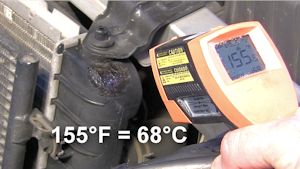We help people repair plastic
Plastic Radiator Repair Kit
If your car radiator has a small leak, you may be wondering if it is possible to repair a plastic radiator and fix a radiator leak. Afterall, there is high-pressure, high-temperature coolant in the radiator tank. You may ask yourself, "How can a radiator epoxy adhesive possibly hold up under those conditions?" The answer is that it probably can't. It may fix the radiator leak temporarily, but over time, the radiator adhesive will, more than likely, come off.
If you take your car to a radiator repair shop to repair a leaking radiator, you will often find that they will repair metal radiator tanks but NOT repair plastic radiator tanks. Instead, the radiator repair shop will probably try to sell you a replacement radiator. The replacement radiator cost can be very high compared to just repairing something so minor and easily repairable.
Radiator tank repairs are not difficult at all. Just keep in mind a few things when you are repairing a cracked plastic radiator tank. First, the repair has to withstand high operating temperatures (200°F or 94°C and up).
Second, the repair has to contain hot, pressurized coolant, making it immediately obvious when your weld is less-than-perfect. Because of the harsh operating conditions, the radiator tanks are made from glass-reinforced nylon, a plastic that features a high-softening point. The high-softening-point nylon plastic is what helps the plastic radiator tank withstand the pressure and temperatures involved.
Adhesives don't stand a chance in such an environment. There's no way an adhesive bond can hold on over the long run at such temperatures with high-pressure water behind it.
The only true way to patch a plastic radiator tank is with a true fusion weld. The Radiator Repair Kit enables you to melt pure nylon fill material directly into the base material, creating a seamless, strong repair that will last for the long haul.
Creating a durable weld repair is not as easy on the radiator as it is on other plastic parts because of the high melting point of the nylon and the harsh operating conditions. However, by following the simple step-by-step procedure we have outlined here, you will be making quality repairs in no time.
Plastic Radiator Repair Video
Step-by-Step - How to Repair a Plastic Radiator Tank
Step 1
If you are repairing the radiator while it is still in the car, drain the antifreeze until the level of the antifreeze is below the crack line. This way, the antifreeze won't seep out of the crack and ruin the repair. Clean the cracked area with Super Prep Plastic Cleaner.
Step 2
If you have a heat gun, you can speed up the repair process by softening the plastic. Preheat the area to be welded with a heat gun. Heat slowly until the area in and around the v-groove begins to turn glossy. On long cracks, preheat a two-inch section at a time and complete the weld in that area before moving on.
Step 3
Melt a V groove along the crack line with the edge of the welder tip.
Step 4
Melt the Nylon rod into the v-groove with the airless plastic welder. The rod should come out melted and a little bit brown, but not discolored too badly. The fumes are not very pleasant, so work in a well-ventilated area.
Step 5
After depositing the nylon rod into the v-groove, remove the rod from the welder tip and use the welder's to mix together the new plastic with the radiator plastic. Keep mixing until the plastic is all one color. You need a good mix of the existing plastic and the new plastic to get maximum strength.
Step 6
Allow time for the plastic to cool and resolidify. Repairing radiators will save you a lot of money compared to a replacement radiator.
Another Radiator Repair Example
Here is another plastic cracked radiator repair. The same methods are used here. We are showing it to reinforce how simple it is to fix a radiator.
Step-by-Step - How to Repair a Plastic Radiator Tank
Step 1
If you are trying to fix the leak in the radiator while it is still in the car, drain the antifreeze until the level of the antifreeze is below the crack line. This way, the antifreeze won't seep out of the crack and ruin the repair. Clean the cracked area with Super Prep Plastic Cleaner.
Step 2
If you are trying to fix the leak in the radiator while it is still in the car, drain the antifreeze until the level of the antifreeze is below the crack line. This way, the antifreeze won't seep out of the crack and ruin the repair. Clean the cracked area with Super Prep Plastic Cleaner.
Step 3
Melt a V groove along the crack line with the edge of the welder tip.
Step 4
Melt the Nylon rod into the v-groove with the airless plastic welder. The rod should come out melted and a little bit brown, but not discolored too badly. The fumes are not very pleasant, so work in a well-ventilated area.
Step 5
After depositing some melted nylon into the v-groove, remove the rod from the welder tip and use the welder's heat to melt the rod and base material together until the weld area is the same color as the rest of the tank. Mix it well so that you get good inter-mixing of the rod and the existing plastic. This is how you know you've got a good fusion weld.
Step 6
Wait for the plastic to cool and resolidify, and you are finished. Repairing radiators will save you a lot of money compared to what a new radiator costs.
Plastic Radiator Repair Procedures
Here is how confident we are with the Radiator Repair Kit.
Radiator Repair Video
Drill a Hole
Polyvance’s radiator repair kit allows you to fix a leaking plastic radiator tank. To show how confident we are with our Radiator repair kit, we drilled a hole in a perfectly good radiator.
Crack the Plastic
Not only did we drill a hole in the radiator, but we cracked the radiator tank with a chisel.
V-Groove along the crack line
Before you start repairing, you will need to drain the radiator until the coolant level is below the hole. Create a V-groove along the crack line about two thirds of the way through the thickness of the plastic. You can either melt in a V-groove, or you can use a rotary tool and grind a v-groove like we did here. Be sure to round of any sharp edges.
Soften plastic with a Heat Gun
Plastic radiator tanks are made of nylon which has a very high melting point of about 425°F (218°C). While it is not required, the repair will go faster if you pre-soften the plastic with a heat gun.
Melt in new material
Melt the Nylon rod into the Vee groove with the plastic welder. The rod should come out melted and a little bit brown, but not discolored too badly.
Mix the new plastic with the old plastic
While the melted rod is still hot, use the tip of the welder to stir together the new plastic and the radiator plastic. Keep mixing until the plastic is all one color. You need a good mix of the existing plastic and the new plastic to achieve maximum strength.
Test Results
The car was started and run for 45 minutes with no signs of leaking.
Products Used For This Repair

